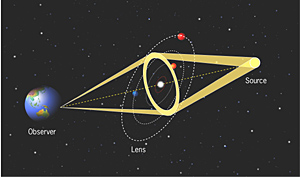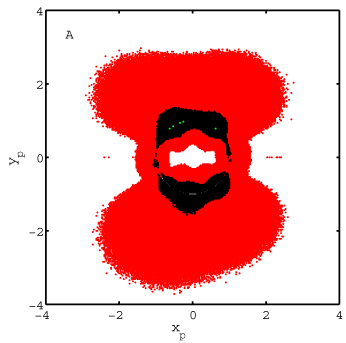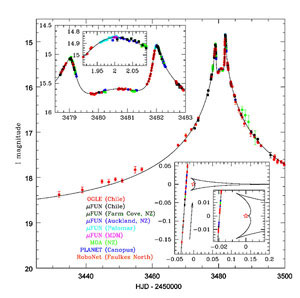EXTRASOLAR PLANETS
One application of gravitational microlensing is the search for planets orbiting distant stars. The radial velocity technique has proved to be successful for detecting gas-giant planets like Jupiter orbiting nearby stars, especially ‘hot Jupiters’ orbiting close to their parent stars.
Extra-solar planets orbiting the lens star of a gravitational microlensing event can betray their presence
through perturbations to the light curve (Gould & Loeb, ApJ Vol. 396, p. 104; Bennett & Rhie, ApJ Vol.
472, p. 660). This technique of searching for planets is complementary to the radial velocity technique, as it
is sensitive to less massive planets than Jupiter orbiting at larger distances than those of the hot Jupiters.
Also, it is sensitive to planets in distant regions of the Galaxy. The technique is illustrated below for an event
of high magnification.

Planets orbiting the lens star in a well-aligned microlensing event can reveal their presence by perturbations
to the Einstein ring. Terrestrial planets may be detected if they lie between about 0.8 and 1.3 Eintein ring radii
from the lens star. Heavier planets may be detected over a broader range of
separations. As the Einstein ring radius is typically about 2 AU, the method
probes an important region. Well-aligned events such as that illustrated above yield high
magnification. Planets may also be detected in events of low magnification. See astro-ph/0409043 and astro-ph/0404309 for further details.
This plot shows the region of sensitivity to Earth-mass planets (black) and
Neptune-mass planets (red) orbiting the lens star of event MOA 2003-BLG-32/OGLE 2003-BLG-219 for which the peak
magnification exceeded 500. The region of sensitivity to Earth-mass planets is comparable in size and position
to the region occupied by the asteroid belt in the solar system. See Science 27 Aug 2004, pp. 1264-1266 for
more details.

High magnification event OGLE 2005-BLG-71 shows clear evidence of a planetary
perturbation. Data were obtained by several telescopes around the globe, including amateur astronomers in New
Zealand, but sufficient data to characterize the planet were obtained by Andrzej Udalski alone using the OGLE
telescope in Chile. See astro-ph/0505451 for details.

